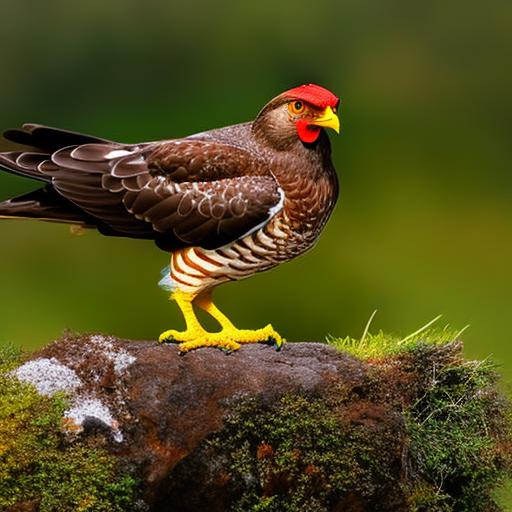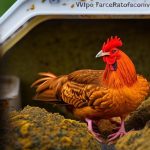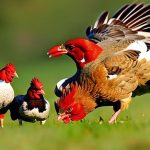Deterring hawks from chickens is a crucial aspect of protecting these beloved farm animals. Hawks are natural predators that pose a significant threat to chickens, as they have sharp talons and beaks that can easily injure or kill them. It is essential for chicken owners to take proactive measures to deter hawks and ensure the safety and well-being of their flock.
Key Takeaways
- Hawks pose a serious threat to chickens and their safety.
- Natural deterrents like roosters and decoys can help deter hawks.
- Artificial deterrents like reflective tape and predator eyes can also be effective.
- Physical barriers like netting and fencing can provide long-term protection.
- A combination of deterrents is often the most effective way to keep hawks away from chickens.
Importance of deterring hawks from chickens
Hawks are a formidable threat to chickens due to their predatory nature. They have keen eyesight and can spot chickens from high altitudes, swooping down with incredible speed and precision. Once a hawk has targeted a chicken, it can cause severe injuries or even kill the bird. This not only results in the loss of valuable livestock but also disrupts the overall dynamics of the flock.
The consequences of not deterring hawks can be devastating for chicken owners. Hawks can decimate an entire flock within a short period, leaving behind a trail of destruction and heartbreak. Additionally, the stress caused by constant hawk attacks can negatively impact the health and productivity of the remaining chickens. Therefore, it is crucial for chicken owners to implement effective deterrents to protect their flock.
Natural deterrents
There are several natural deterrents that can be used to keep hawks away from chickens. One effective method is to introduce larger birds of prey into the area, such as owls or falcons. These birds are natural predators of hawks and their presence can deter hawks from approaching the chicken coop or free-range area.
Another natural deterrent is the use of reflective objects, such as CDs or aluminum foil strips, which create flashes of light that can startle and confuse hawks. The movement and reflection of these objects mimic the presence of predators, making hawks think twice before attacking.
Additionally, planting tall trees or installing tall poles near the chicken coop can provide cover for chickens, making it more difficult for hawks to spot them from above. The dense foliage or height of these structures can create a barrier that hawks are less likely to penetrate.
Artificial deterrents
Artificial deterrents can also be effective in deterring hawks from chickens. One popular method is the use of scarecrows or decoy predators, such as plastic owls or hawks. These decoys create the illusion of a larger predator in the area, causing hawks to think twice before approaching.
Another artificial deterrent is the use of reflective tape or streamers. Similar to reflective objects, these items create flashes of light that startle and confuse hawks. The movement and reflection of the tape or streamers mimic the presence of predators, deterring hawks from attacking.
Furthermore, there are commercially available hawk repellents that can be sprayed around the chicken coop or free-range area. These repellents often contain natural ingredients that emit odors or tastes that hawks find unpleasant, discouraging them from approaching.
Physical barriers
Physical barriers are an effective way to protect chickens from hawks. One common method is to install netting or wire mesh over the chicken coop or free-range area. This creates a physical barrier that prevents hawks from accessing the chickens.
Another option is to construct a covered run for the chickens, using materials such as wood or metal. This enclosed space provides protection from aerial attacks and allows chickens to roam freely without the risk of hawk predation.
Sound deterrents

Sound deterrents can be an effective way to keep hawks away from chickens. One popular method is the use of predator calls or distress calls. These recordings mimic the sounds made by predators or distressed animals, signaling danger to hawks and deterring them from approaching.
Another sound deterrent is the use of wind chimes or bells. The constant noise created by these objects can startle and confuse hawks, making them think twice before attacking.
Visual deterrents
Visual deterrents can be an effective way to deter hawks from chickens. One method is the use of scare balloons or kites. These objects are designed to resemble predators or other threats, creating a visual deterrent that hawks find intimidating.
Another visual deterrent is the use of brightly colored flags or ribbons. The movement and color of these objects can startle and confuse hawks, making them think twice before attacking.
Motion-activated deterrents
Motion-activated deterrents can be highly effective in deterring hawks from chickens. One popular option is the use of motion-activated sprinklers. These devices are equipped with sensors that detect the presence of hawks and release a burst of water, startling and deterring them.
Another motion-activated deterrent is the use of motion-activated lights or noise devices. These devices are triggered by the movement of hawks and emit bright lights or loud noises, scaring them away.
Combination of deterrents
Using a combination of deterrents can be more effective than relying on just one method. For example, combining physical barriers with sound deterrents and visual deterrents creates multiple layers of protection for chickens. This multi-faceted approach makes it more difficult for hawks to overcome the deterrents and increases the chances of successfully deterring them.
Conclusion and recommendations for chicken owners
In conclusion, deterring hawks from chickens is crucial for the safety and well-being of these farm animals. Hawks pose a significant threat to chickens, and their attacks can result in severe injuries or death. By implementing a combination of natural deterrents, artificial deterrents, physical barriers, sound deterrents, visual deterrents, and motion-activated deterrents, chicken owners can effectively protect their flock from hawk predation.
It is recommended that chicken owners assess their specific situation and choose the deterrents that are most suitable for their needs. Additionally, it is important to regularly inspect and maintain the deterrents to ensure their effectiveness. By taking proactive measures to deter hawks, chicken owners can create a safe and secure environment for their flock.
Readers are encouraged to share their own experiences and tips in the comments section below, as this can provide valuable insights and additional strategies for deterring hawks from chickens. Together, we can help chicken owners protect their beloved flock from these formidable predators.
If you’re looking for the best deterrents to keep hawks away from your chickens, you might find this article on poultrywizard.com helpful. It discusses various methods and strategies to protect your flock from these predatory birds. From scare tactics to physical barriers, the article provides valuable insights on how to safeguard your chickens. Check it out here for more information.
FAQs
What are hawks?
Hawks are birds of prey that belong to the family Accipitridae. They are known for their sharp talons, hooked beaks, and keen eyesight, which they use to hunt and kill small animals.
Why do hawks attack chickens?
Hawks see chickens as a source of food, and they will attack them if they get the chance. Chickens are easy prey for hawks because they are slow-moving and cannot fly very high.
What are the best deterrents to keep hawks away from chickens?
Some of the best deterrents to keep hawks away from chickens include netting, fencing, scarecrows, and reflective tape. These methods can help to make your chicken coop and yard less attractive to hawks.
How does netting work as a hawk deterrent?
Netting can be used to cover the top of your chicken coop and yard, which will prevent hawks from swooping down and attacking your chickens. The netting should be strong enough to withstand the weight of a hawk and should be secured tightly to prevent any gaps.
What kind of fencing is best for keeping hawks away?
A sturdy, high fence made of wire mesh or chicken wire can be effective in keeping hawks away from your chickens. The fence should be at least 6 feet high and should be buried at least 6 inches into the ground to prevent hawks from digging underneath.
How do scarecrows work as a hawk deterrent?
Scarecrows can be used to frighten hawks away from your chicken coop and yard. You can make a scarecrow by stuffing old clothes with straw or other materials and placing it in a visible location. The scarecrow should be moved around periodically to prevent hawks from getting used to it.
How does reflective tape work as a hawk deterrent?
Reflective tape can be hung around your chicken coop and yard to create a visual deterrent for hawks. The tape reflects light and creates a flashing effect that can scare hawks away. The tape should be hung in a visible location and should be moved around periodically to prevent hawks from getting used to it.
Meet Walter, the feathered-friend fanatic of Florida! Nestled in the sunshine state, Walter struts through life with his feathered companions, clucking his way to happiness. With a coop that’s fancier than a five-star hotel, he’s the Don Juan of the chicken world. When he’s not teaching his hens to do the cha-cha, you’ll find him in a heated debate with his prized rooster, Sir Clucks-a-Lot. Walter’s poultry passion is no yolk; he’s the sunny-side-up guy you never knew you needed in your flock of friends!







